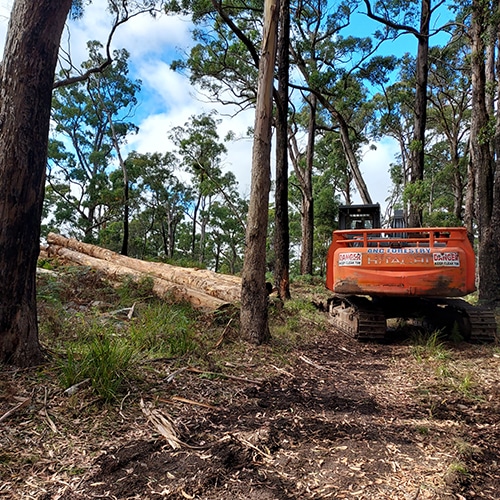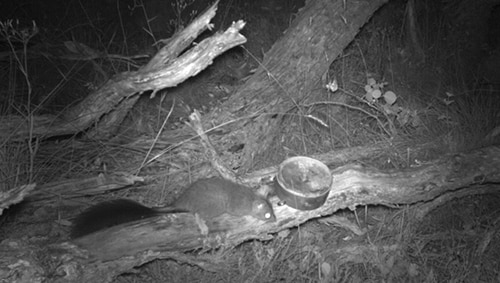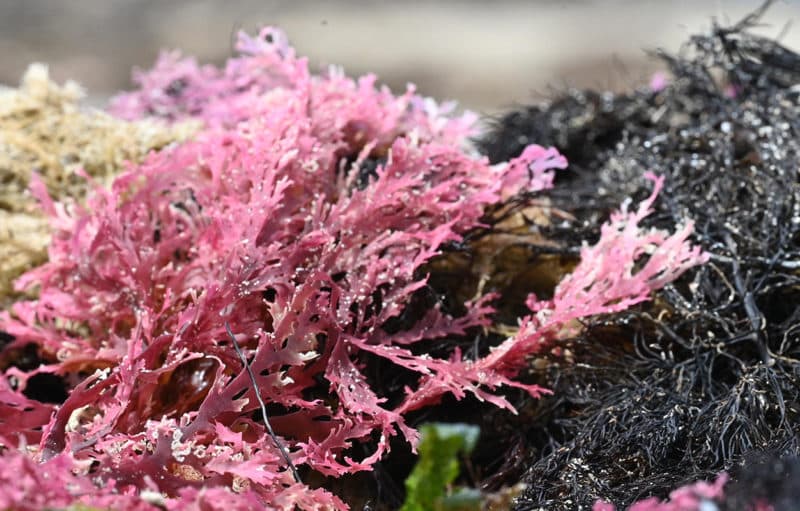PARK WATCH Article March 2023 |
Nature Conservation Campaigner Ben Gill encounters cute critters and menacing machines whilst investigating dubious logging practices in the Cobaw State Forest
An alarming pattern of justifications is being used to gain access to restricted or protected conservation areas. Parts of the Cobaw Ranges are the latest to fall victim to problematic ‘storm recovery’ and fire mitigation works.
The Cobaw State Forest is located near Lancefield, 70 km north-west of Melbourne in the Cobaw Ranges. The ranges are mainly granitic and reach a maximum height of 760 metres. The area is unique in that it serves as an island haven for biodiversity in a sea of cleared farmland. The Cobaws are almost wholly covered by a Special Protection Zone (SPZ) managed for conservation. These were also recommended by the Central West VEAC Investigation for the Cobaw State Forest to become a new 2,532 hectare conservation park, which was accepted by the Andrews Government in June 2021.
VNPA discovered seven coupes listed on VicForests’ website. Equipped with the spatial data, we conducted a thorough site survey and were left greatly perplexed by the limited storm damage visible using on ground investigation, drone and photographic records. We eventually made contact with the Department of Energy, Environment and Climate Action (DEECA, formerly DELWP) Forest Management, who are running the program, to highlight issues related to ‘salvage logging’ in the proposed conservation park and SPZ.
We also held concerns about the impacts to the understorey and groundcovers from the compaction of 45–60 tonne logging equipment, especially as the area was recovering after being extensively burnt in a DELWP planned burn that jumped containment lines in October 2015.
Our concerns were noted. DEECA reached out to assure us there would be no ‘broad acre’ storm recovery works in the Cobaws. They said works would be restricted to roadside clean up for fire mitigation purposes (in other words, a smash and grab ‘forest recovery’ operation carried out solely by VicForests). Detail was sparse as to the scope, timing and locations of the proposed works, and we were unpleasantly surprised when a concerned local community environment group alerted us to machinery movement in the area.

The ghostly machine
Now this is where it gets a bit fishy … VNPA staff attended Reillys Track deep in the forest where a machine had been noted in earlier surveys. Upon arriving at the location we found no machine but could see the unmistakable paw prints of a 45 tonne log stripper meandering up a deeply rutted and almost impassable 4WD track to a beautiful area of habitat. This area features mixed age healthy trees including Messmate (Eucalyptus obliqua), Candlebark (E. rubida) and Manna Gum (E. viminalis). The understorey consists of Silver Wattle (Acacia dealbata), Blackwood (A. melanoxylon) and Cherry Ballart (Exocarpos cupressiformis).
Due to the presence of safety work zone signage we recorded the GPS position and took reference photos. VNPA staff submitted a report to the Office of the Conservation Regulator (OCR) and DEECA asking for confirmation of work zones as the location failed to fall into any of the areas previously discussed with the department. On the same day a local environmental citizen science project recorded Brush-tailed Phascogales (Phascogale tapoatafa tapoatafa) on two separate cameras. The ground in the location they were recorded featured a healthy natural cover of debris, providing an ideal foraging location for the insects and bugs that Phascogales rely upon.
Excited by the findings on the camera trip, we decided to return to the Cobaws to move the cameras and check on the machine ‘working’ deep in the forest far from any real fire access track. We were appalled to find two large log piles 100 metres apart, extensive damage to the ground cover off-track and crushed granite from the weight of the machine that may have once been home to reptiles and insects. We took GPS coordinates from the locations of the machine and the log piles.
Early the next day we received a call from DEECA responding to the previous week’s request for more information on the log stripper working in the Cobaw. We were informed that DEECA and VicForests had attended the site indicated in our report and could not find the machine or see any sign of the presence of one. It was suggested that our GPS pin drop may have been off target. This was checked three times in spatial software as being correct.
A little perplexed at the possibility we may have caught a rare glimpse of the ‘phantom logging machine’ in an area outside of its expected habitat range, we reconfirmed the position with a third site visit and pin drop. It is strange to think that a machine such as this – so cleanly stripping logs and leaving behind vast tendrils of fine fuels in its wake – was apparently not being actively monitored.

Who’s on first, what’s on second?
This creates a spaghetti of confusion over who is responsible for what, who has oversight over whom, and which legislation trumps another in a constant rendition of ‘rock, paper, scissors’ transformed as ‘The Forests Act, The Water Act and Regional Forest Agreements’.
DEECA are responsible for fire risk management in state forest, national parks and conservation reserves, and contract VicForests to do the works. But the works aren’t forestry for possible commercial purposes (even though they are cutting down or removing logs) and undertaking ‘storm recovery’ combined with ‘fire mitigation’ is a dangerous trend toward increasing use of the fire powers to gain access to previously protected areas such as the Cobaws SPZs. Of course, they shouldn’t be logging in there because it’s a water catchment but… but the fire act and emergency storm powers mean they can!
A further twist is that the OCR have reiterated that as this ‘a fire mitigation’ operation they have no oversight even though the operation is being physically conducted by VicForests contractors and staff under the supposed supervision of DEECA. So the plot thickens and the waters are further silted while the machinery of government rides roughshod over any hope of holding this rogue industry to account.
Oversight, accountability and clarity are what is needed if we are to have any hope of restoring these forest habitats. But with the current glacial pace of permanent protections there’s a real risk it will be too late.
As authorities balance public safety, protections for the natural environment and pressures from the timber industry, we’ll continue to emphasise the intense need for transparency and independent oversight.
- Read the latest full edition of Park Watch magazine
- Subscribe to keep up-to-date about this and other nature issues in Victoria
- Become a member to receive Park Watch magazine in print
